Applications of 3D Printing in Medicine: Successes and Challenges
VerifiedAdded on 2023/06/14
|10
|3303
|136
Report
AI Summary
This report provides a comprehensive overview of the applications, success rates, and complexities of 3D printing in medicine. It begins by introducing the use of patient-centered 3D printed models derived from CT and MRI scans for pre-surgical planning and treatment. The report then discusses the unique opportunities 3D printing presents for biomedical research and medical product development, highlighting its role in improving doctor-patient compliance and understanding anatomical physiology. An analysis of past uses reveals its potential to revolutionize healthcare, from creating patient-specific organ replicas for surgical practice to producing custom-made prosthetics. The report also addresses the challenges associated with 3D printing, including binder selection, mechanical properties, dimensional accuracy, and staff re-education. Overall, the report emphasizes the transformative impact of 3D printing on medicine, offering insights into its current applications and future potential.
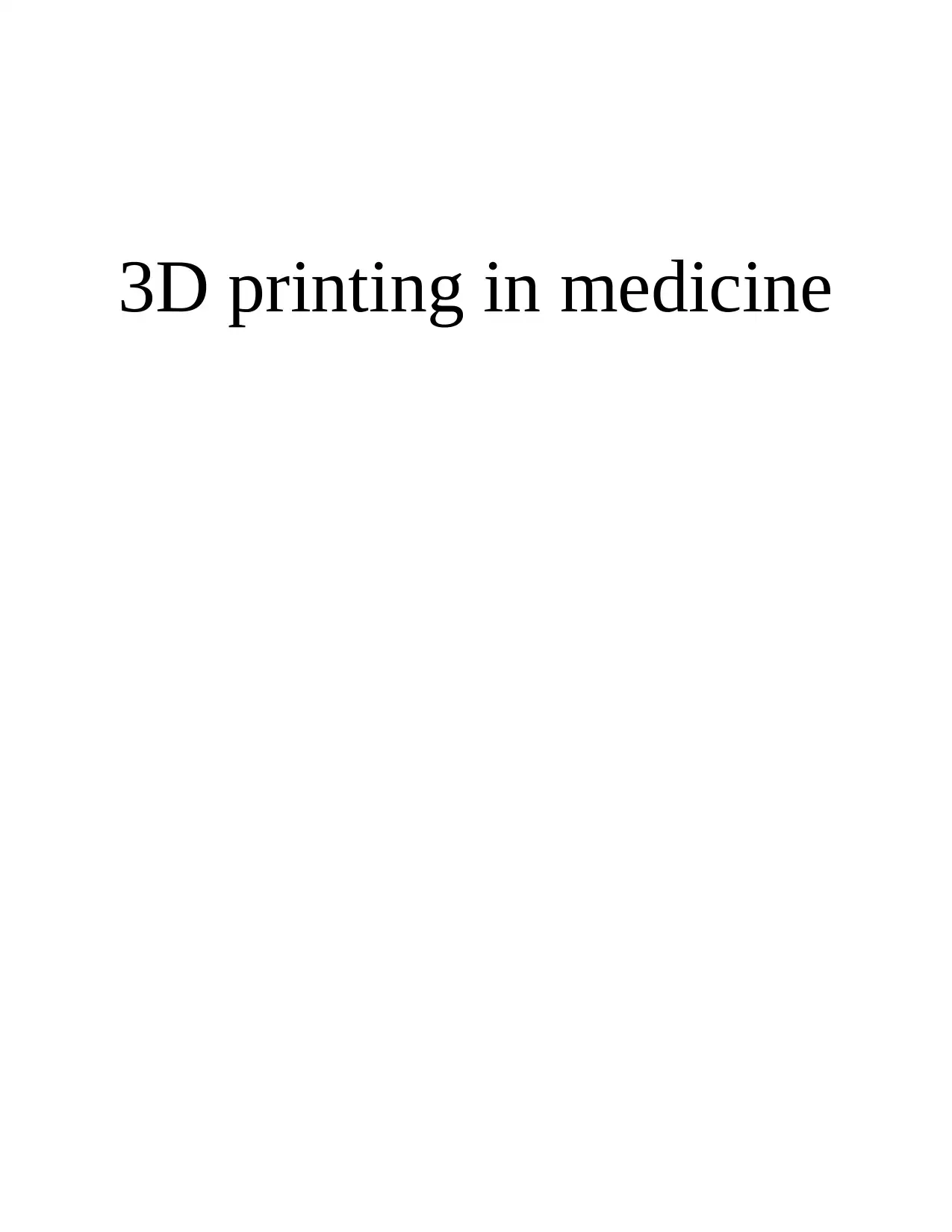
3D printing in medicine
Paraphrase This Document
Need a fresh take? Get an instant paraphrase of this document with our AI Paraphraser

Table of Contents
INTRODUCTION...........................................................................................................................1
MAIN BODY...................................................................................................................................1
1: Introduction to title.............................................................................................................1
2: concept and application of 3D printing in medical field....................................................2
3: Success rates of past uses of 3D printing in the medical field...........................................3
4: Complexity of 3d printing..................................................................................................4
CONCLUSION................................................................................................................................6
REFERENCES................................................................................................................................7
INTRODUCTION...........................................................................................................................1
MAIN BODY...................................................................................................................................1
1: Introduction to title.............................................................................................................1
2: concept and application of 3D printing in medical field....................................................2
3: Success rates of past uses of 3D printing in the medical field...........................................3
4: Complexity of 3d printing..................................................................................................4
CONCLUSION................................................................................................................................6
REFERENCES................................................................................................................................7
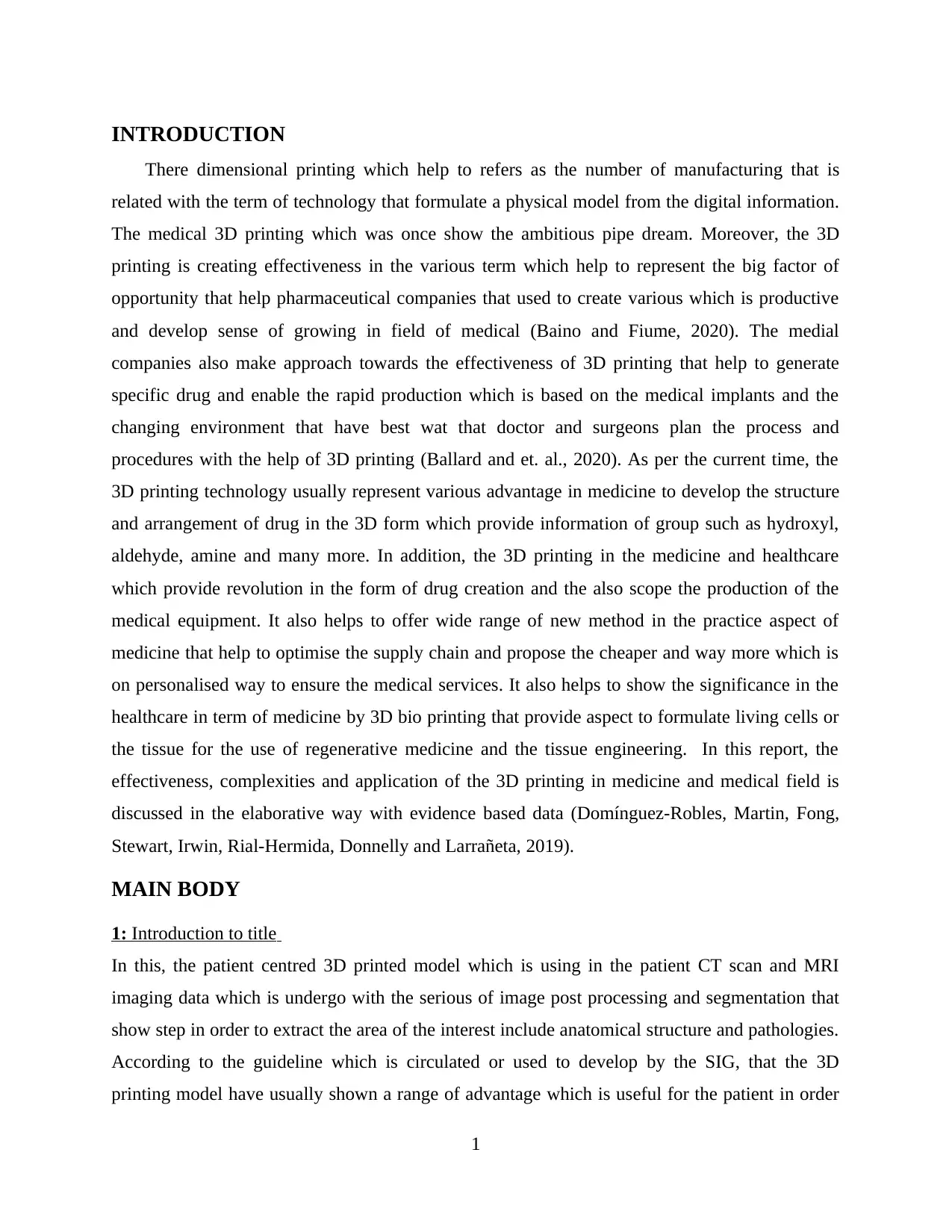
INTRODUCTION
There dimensional printing which help to refers as the number of manufacturing that is
related with the term of technology that formulate a physical model from the digital information.
The medical 3D printing which was once show the ambitious pipe dream. Moreover, the 3D
printing is creating effectiveness in the various term which help to represent the big factor of
opportunity that help pharmaceutical companies that used to create various which is productive
and develop sense of growing in field of medical (Baino and Fiume, 2020). The medial
companies also make approach towards the effectiveness of 3D printing that help to generate
specific drug and enable the rapid production which is based on the medical implants and the
changing environment that have best wat that doctor and surgeons plan the process and
procedures with the help of 3D printing (Ballard and et. al., 2020). As per the current time, the
3D printing technology usually represent various advantage in medicine to develop the structure
and arrangement of drug in the 3D form which provide information of group such as hydroxyl,
aldehyde, amine and many more. In addition, the 3D printing in the medicine and healthcare
which provide revolution in the form of drug creation and the also scope the production of the
medical equipment. It also helps to offer wide range of new method in the practice aspect of
medicine that help to optimise the supply chain and propose the cheaper and way more which is
on personalised way to ensure the medical services. It also helps to show the significance in the
healthcare in term of medicine by 3D bio printing that provide aspect to formulate living cells or
the tissue for the use of regenerative medicine and the tissue engineering. In this report, the
effectiveness, complexities and application of the 3D printing in medicine and medical field is
discussed in the elaborative way with evidence based data (Domínguez-Robles, Martin, Fong,
Stewart, Irwin, Rial-Hermida, Donnelly and Larrañeta, 2019).
MAIN BODY
1: Introduction to title
In this, the patient centred 3D printed model which is using in the patient CT scan and MRI
imaging data which is undergo with the serious of image post processing and segmentation that
show step in order to extract the area of the interest include anatomical structure and pathologies.
According to the guideline which is circulated or used to develop by the SIG, that the 3D
printing model have usually shown a range of advantage which is useful for the patient in order
1
There dimensional printing which help to refers as the number of manufacturing that is
related with the term of technology that formulate a physical model from the digital information.
The medical 3D printing which was once show the ambitious pipe dream. Moreover, the 3D
printing is creating effectiveness in the various term which help to represent the big factor of
opportunity that help pharmaceutical companies that used to create various which is productive
and develop sense of growing in field of medical (Baino and Fiume, 2020). The medial
companies also make approach towards the effectiveness of 3D printing that help to generate
specific drug and enable the rapid production which is based on the medical implants and the
changing environment that have best wat that doctor and surgeons plan the process and
procedures with the help of 3D printing (Ballard and et. al., 2020). As per the current time, the
3D printing technology usually represent various advantage in medicine to develop the structure
and arrangement of drug in the 3D form which provide information of group such as hydroxyl,
aldehyde, amine and many more. In addition, the 3D printing in the medicine and healthcare
which provide revolution in the form of drug creation and the also scope the production of the
medical equipment. It also helps to offer wide range of new method in the practice aspect of
medicine that help to optimise the supply chain and propose the cheaper and way more which is
on personalised way to ensure the medical services. It also helps to show the significance in the
healthcare in term of medicine by 3D bio printing that provide aspect to formulate living cells or
the tissue for the use of regenerative medicine and the tissue engineering. In this report, the
effectiveness, complexities and application of the 3D printing in medicine and medical field is
discussed in the elaborative way with evidence based data (Domínguez-Robles, Martin, Fong,
Stewart, Irwin, Rial-Hermida, Donnelly and Larrañeta, 2019).
MAIN BODY
1: Introduction to title
In this, the patient centred 3D printed model which is using in the patient CT scan and MRI
imaging data which is undergo with the serious of image post processing and segmentation that
show step in order to extract the area of the interest include anatomical structure and pathologies.
According to the guideline which is circulated or used to develop by the SIG, that the 3D
printing model have usually shown a range of advantage which is useful for the patient in order
1
⊘ This is a preview!⊘
Do you want full access?
Subscribe today to unlock all pages.

Trusted by 1+ million students worldwide
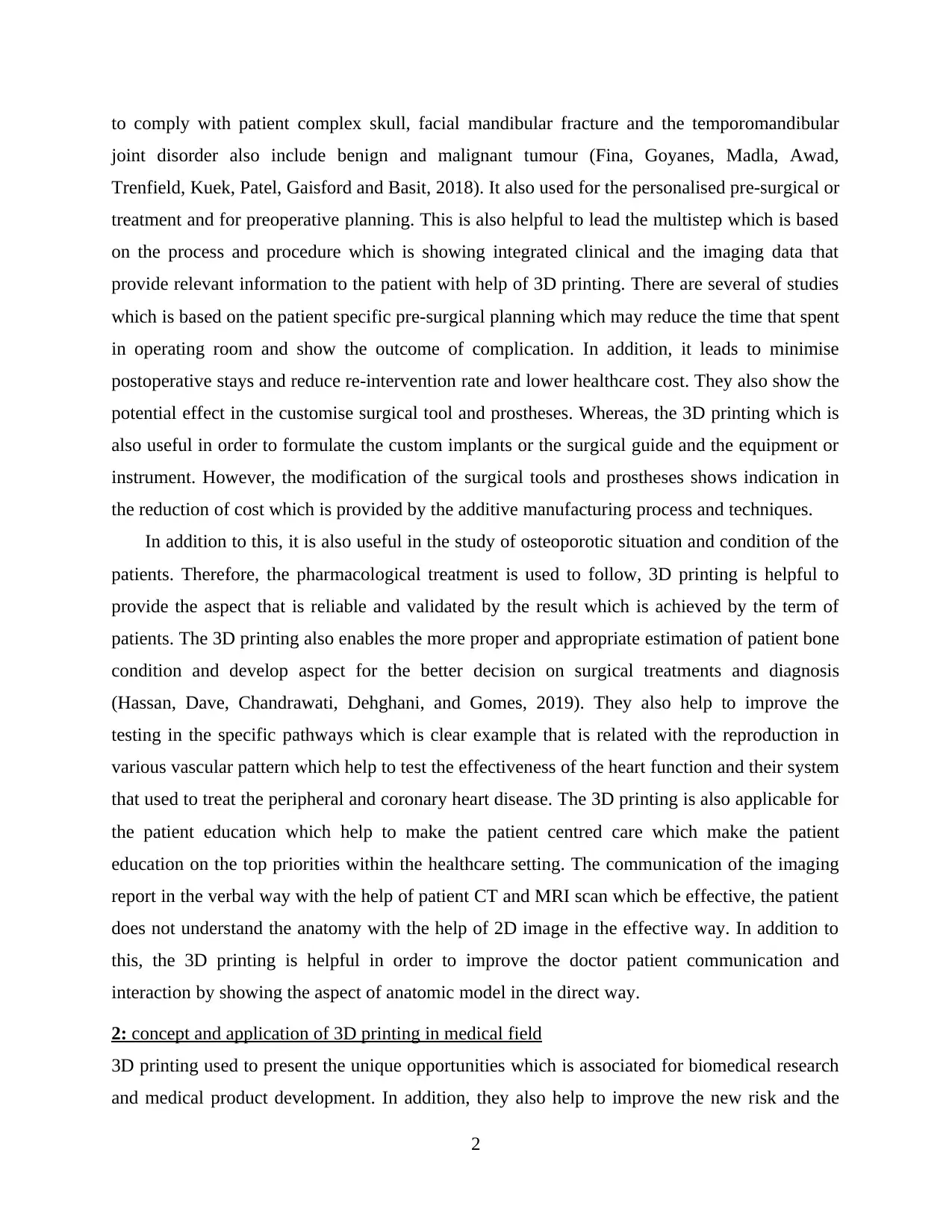
to comply with patient complex skull, facial mandibular fracture and the temporomandibular
joint disorder also include benign and malignant tumour (Fina, Goyanes, Madla, Awad,
Trenfield, Kuek, Patel, Gaisford and Basit, 2018). It also used for the personalised pre-surgical or
treatment and for preoperative planning. This is also helpful to lead the multistep which is based
on the process and procedure which is showing integrated clinical and the imaging data that
provide relevant information to the patient with help of 3D printing. There are several of studies
which is based on the patient specific pre-surgical planning which may reduce the time that spent
in operating room and show the outcome of complication. In addition, it leads to minimise
postoperative stays and reduce re-intervention rate and lower healthcare cost. They also show the
potential effect in the customise surgical tool and prostheses. Whereas, the 3D printing which is
also useful in order to formulate the custom implants or the surgical guide and the equipment or
instrument. However, the modification of the surgical tools and prostheses shows indication in
the reduction of cost which is provided by the additive manufacturing process and techniques.
In addition to this, it is also useful in the study of osteoporotic situation and condition of the
patients. Therefore, the pharmacological treatment is used to follow, 3D printing is helpful to
provide the aspect that is reliable and validated by the result which is achieved by the term of
patients. The 3D printing also enables the more proper and appropriate estimation of patient bone
condition and develop aspect for the better decision on surgical treatments and diagnosis
(Hassan, Dave, Chandrawati, Dehghani, and Gomes, 2019). They also help to improve the
testing in the specific pathways which is clear example that is related with the reproduction in
various vascular pattern which help to test the effectiveness of the heart function and their system
that used to treat the peripheral and coronary heart disease. The 3D printing is also applicable for
the patient education which help to make the patient centred care which make the patient
education on the top priorities within the healthcare setting. The communication of the imaging
report in the verbal way with the help of patient CT and MRI scan which be effective, the patient
does not understand the anatomy with the help of 2D image in the effective way. In addition to
this, the 3D printing is helpful in order to improve the doctor patient communication and
interaction by showing the aspect of anatomic model in the direct way.
2: concept and application of 3D printing in medical field
3D printing used to present the unique opportunities which is associated for biomedical research
and medical product development. In addition, they also help to improve the new risk and the
2
joint disorder also include benign and malignant tumour (Fina, Goyanes, Madla, Awad,
Trenfield, Kuek, Patel, Gaisford and Basit, 2018). It also used for the personalised pre-surgical or
treatment and for preoperative planning. This is also helpful to lead the multistep which is based
on the process and procedure which is showing integrated clinical and the imaging data that
provide relevant information to the patient with help of 3D printing. There are several of studies
which is based on the patient specific pre-surgical planning which may reduce the time that spent
in operating room and show the outcome of complication. In addition, it leads to minimise
postoperative stays and reduce re-intervention rate and lower healthcare cost. They also show the
potential effect in the customise surgical tool and prostheses. Whereas, the 3D printing which is
also useful in order to formulate the custom implants or the surgical guide and the equipment or
instrument. However, the modification of the surgical tools and prostheses shows indication in
the reduction of cost which is provided by the additive manufacturing process and techniques.
In addition to this, it is also useful in the study of osteoporotic situation and condition of the
patients. Therefore, the pharmacological treatment is used to follow, 3D printing is helpful to
provide the aspect that is reliable and validated by the result which is achieved by the term of
patients. The 3D printing also enables the more proper and appropriate estimation of patient bone
condition and develop aspect for the better decision on surgical treatments and diagnosis
(Hassan, Dave, Chandrawati, Dehghani, and Gomes, 2019). They also help to improve the
testing in the specific pathways which is clear example that is related with the reproduction in
various vascular pattern which help to test the effectiveness of the heart function and their system
that used to treat the peripheral and coronary heart disease. The 3D printing is also applicable for
the patient education which help to make the patient centred care which make the patient
education on the top priorities within the healthcare setting. The communication of the imaging
report in the verbal way with the help of patient CT and MRI scan which be effective, the patient
does not understand the anatomy with the help of 2D image in the effective way. In addition to
this, the 3D printing is helpful in order to improve the doctor patient communication and
interaction by showing the aspect of anatomic model in the direct way.
2: concept and application of 3D printing in medical field
3D printing used to present the unique opportunities which is associated for biomedical research
and medical product development. In addition, they also help to improve the new risk and the
2
Paraphrase This Document
Need a fresh take? Get an instant paraphrase of this document with our AI Paraphraser
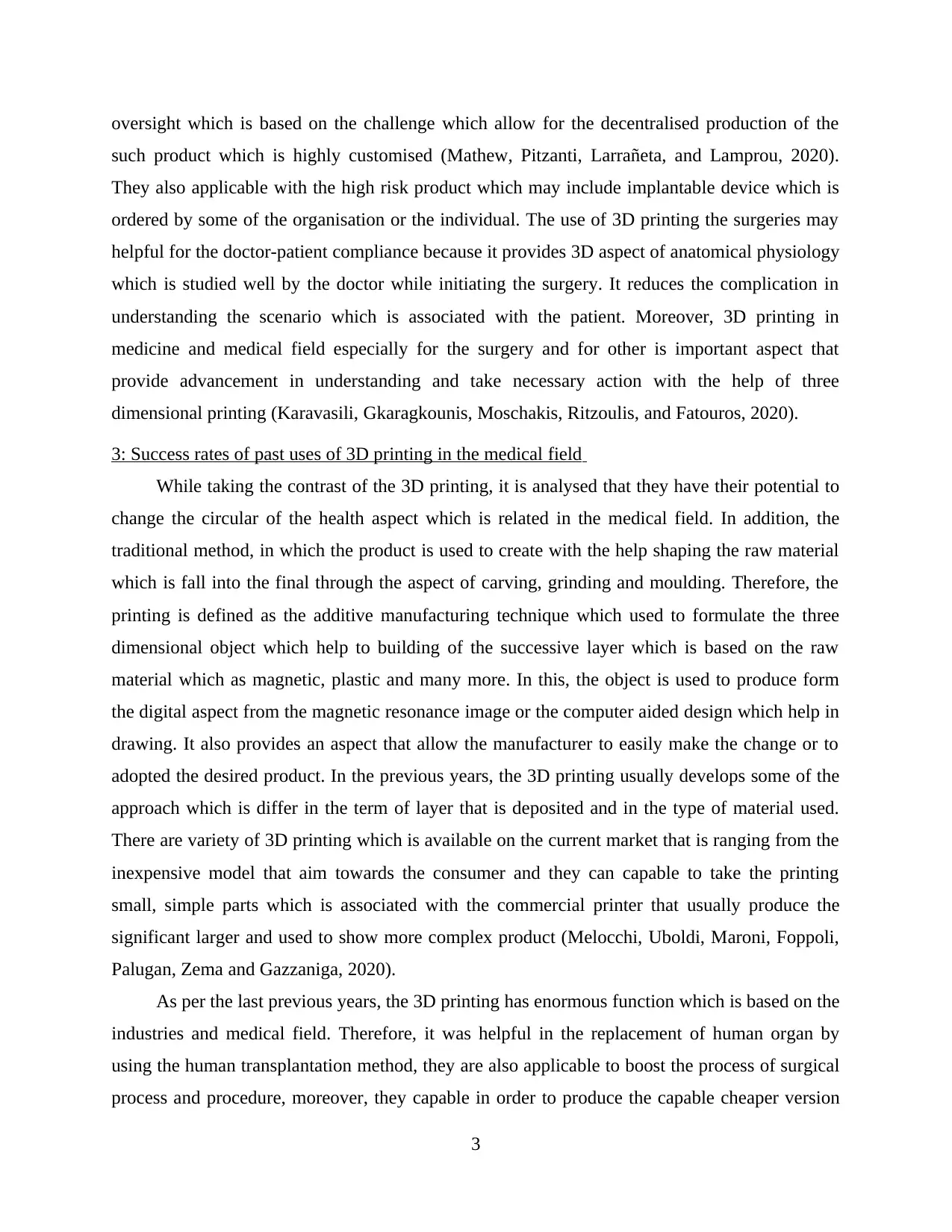
oversight which is based on the challenge which allow for the decentralised production of the
such product which is highly customised (Mathew, Pitzanti, Larrañeta, and Lamprou, 2020).
They also applicable with the high risk product which may include implantable device which is
ordered by some of the organisation or the individual. The use of 3D printing the surgeries may
helpful for the doctor-patient compliance because it provides 3D aspect of anatomical physiology
which is studied well by the doctor while initiating the surgery. It reduces the complication in
understanding the scenario which is associated with the patient. Moreover, 3D printing in
medicine and medical field especially for the surgery and for other is important aspect that
provide advancement in understanding and take necessary action with the help of three
dimensional printing (Karavasili, Gkaragkounis, Moschakis, Ritzoulis, and Fatouros, 2020).
3: Success rates of past uses of 3D printing in the medical field
While taking the contrast of the 3D printing, it is analysed that they have their potential to
change the circular of the health aspect which is related in the medical field. In addition, the
traditional method, in which the product is used to create with the help shaping the raw material
which is fall into the final through the aspect of carving, grinding and moulding. Therefore, the
printing is defined as the additive manufacturing technique which used to formulate the three
dimensional object which help to building of the successive layer which is based on the raw
material which as magnetic, plastic and many more. In this, the object is used to produce form
the digital aspect from the magnetic resonance image or the computer aided design which help in
drawing. It also provides an aspect that allow the manufacturer to easily make the change or to
adopted the desired product. In the previous years, the 3D printing usually develops some of the
approach which is differ in the term of layer that is deposited and in the type of material used.
There are variety of 3D printing which is available on the current market that is ranging from the
inexpensive model that aim towards the consumer and they can capable to take the printing
small, simple parts which is associated with the commercial printer that usually produce the
significant larger and used to show more complex product (Melocchi, Uboldi, Maroni, Foppoli,
Palugan, Zema and Gazzaniga, 2020).
As per the last previous years, the 3D printing has enormous function which is based on the
industries and medical field. Therefore, it was helpful in the replacement of human organ by
using the human transplantation method, they are also applicable to boost the process of surgical
process and procedure, moreover, they capable in order to produce the capable cheaper version
3
such product which is highly customised (Mathew, Pitzanti, Larrañeta, and Lamprou, 2020).
They also applicable with the high risk product which may include implantable device which is
ordered by some of the organisation or the individual. The use of 3D printing the surgeries may
helpful for the doctor-patient compliance because it provides 3D aspect of anatomical physiology
which is studied well by the doctor while initiating the surgery. It reduces the complication in
understanding the scenario which is associated with the patient. Moreover, 3D printing in
medicine and medical field especially for the surgery and for other is important aspect that
provide advancement in understanding and take necessary action with the help of three
dimensional printing (Karavasili, Gkaragkounis, Moschakis, Ritzoulis, and Fatouros, 2020).
3: Success rates of past uses of 3D printing in the medical field
While taking the contrast of the 3D printing, it is analysed that they have their potential to
change the circular of the health aspect which is related in the medical field. In addition, the
traditional method, in which the product is used to create with the help shaping the raw material
which is fall into the final through the aspect of carving, grinding and moulding. Therefore, the
printing is defined as the additive manufacturing technique which used to formulate the three
dimensional object which help to building of the successive layer which is based on the raw
material which as magnetic, plastic and many more. In this, the object is used to produce form
the digital aspect from the magnetic resonance image or the computer aided design which help in
drawing. It also provides an aspect that allow the manufacturer to easily make the change or to
adopted the desired product. In the previous years, the 3D printing usually develops some of the
approach which is differ in the term of layer that is deposited and in the type of material used.
There are variety of 3D printing which is available on the current market that is ranging from the
inexpensive model that aim towards the consumer and they can capable to take the printing
small, simple parts which is associated with the commercial printer that usually produce the
significant larger and used to show more complex product (Melocchi, Uboldi, Maroni, Foppoli,
Palugan, Zema and Gazzaniga, 2020).
As per the last previous years, the 3D printing has enormous function which is based on the
industries and medical field. Therefore, it was helpful in the replacement of human organ by
using the human transplantation method, they are also applicable to boost the process of surgical
process and procedure, moreover, they capable in order to produce the capable cheaper version
3
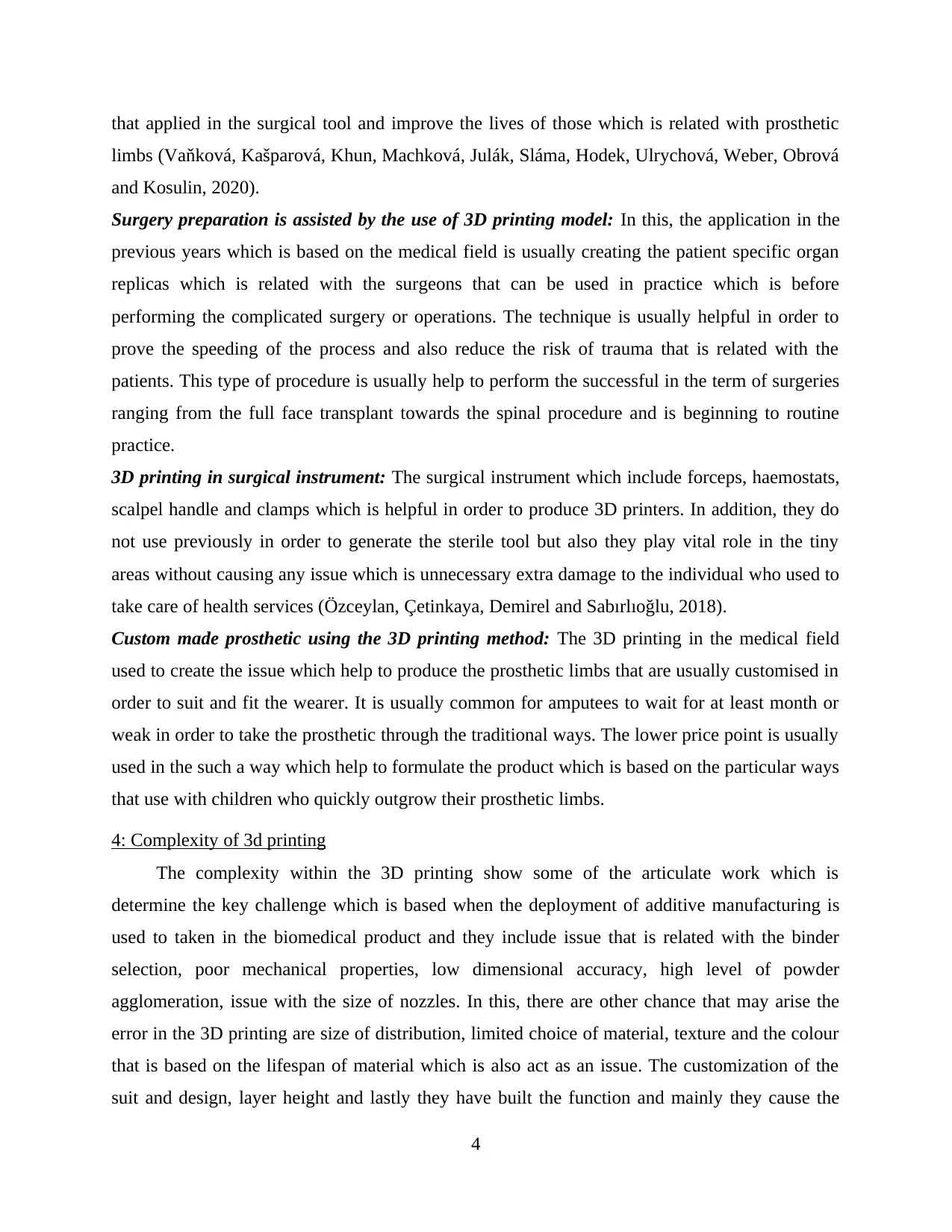
that applied in the surgical tool and improve the lives of those which is related with prosthetic
limbs (Vaňková, Kašparová, Khun, Machková, Julák, Sláma, Hodek, Ulrychová, Weber, Obrová
and Kosulin, 2020).
Surgery preparation is assisted by the use of 3D printing model: In this, the application in the
previous years which is based on the medical field is usually creating the patient specific organ
replicas which is related with the surgeons that can be used in practice which is before
performing the complicated surgery or operations. The technique is usually helpful in order to
prove the speeding of the process and also reduce the risk of trauma that is related with the
patients. This type of procedure is usually help to perform the successful in the term of surgeries
ranging from the full face transplant towards the spinal procedure and is beginning to routine
practice.
3D printing in surgical instrument: The surgical instrument which include forceps, haemostats,
scalpel handle and clamps which is helpful in order to produce 3D printers. In addition, they do
not use previously in order to generate the sterile tool but also they play vital role in the tiny
areas without causing any issue which is unnecessary extra damage to the individual who used to
take care of health services (Özceylan, Çetinkaya, Demirel and Sabırlıoğlu, 2018).
Custom made prosthetic using the 3D printing method: The 3D printing in the medical field
used to create the issue which help to produce the prosthetic limbs that are usually customised in
order to suit and fit the wearer. It is usually common for amputees to wait for at least month or
weak in order to take the prosthetic through the traditional ways. The lower price point is usually
used in the such a way which help to formulate the product which is based on the particular ways
that use with children who quickly outgrow their prosthetic limbs.
4: Complexity of 3d printing
The complexity within the 3D printing show some of the articulate work which is
determine the key challenge which is based when the deployment of additive manufacturing is
used to taken in the biomedical product and they include issue that is related with the binder
selection, poor mechanical properties, low dimensional accuracy, high level of powder
agglomeration, issue with the size of nozzles. In this, there are other chance that may arise the
error in the 3D printing are size of distribution, limited choice of material, texture and the colour
that is based on the lifespan of material which is also act as an issue. The customization of the
suit and design, layer height and lastly they have built the function and mainly they cause the
4
limbs (Vaňková, Kašparová, Khun, Machková, Julák, Sláma, Hodek, Ulrychová, Weber, Obrová
and Kosulin, 2020).
Surgery preparation is assisted by the use of 3D printing model: In this, the application in the
previous years which is based on the medical field is usually creating the patient specific organ
replicas which is related with the surgeons that can be used in practice which is before
performing the complicated surgery or operations. The technique is usually helpful in order to
prove the speeding of the process and also reduce the risk of trauma that is related with the
patients. This type of procedure is usually help to perform the successful in the term of surgeries
ranging from the full face transplant towards the spinal procedure and is beginning to routine
practice.
3D printing in surgical instrument: The surgical instrument which include forceps, haemostats,
scalpel handle and clamps which is helpful in order to produce 3D printers. In addition, they do
not use previously in order to generate the sterile tool but also they play vital role in the tiny
areas without causing any issue which is unnecessary extra damage to the individual who used to
take care of health services (Özceylan, Çetinkaya, Demirel and Sabırlıoğlu, 2018).
Custom made prosthetic using the 3D printing method: The 3D printing in the medical field
used to create the issue which help to produce the prosthetic limbs that are usually customised in
order to suit and fit the wearer. It is usually common for amputees to wait for at least month or
weak in order to take the prosthetic through the traditional ways. The lower price point is usually
used in the such a way which help to formulate the product which is based on the particular ways
that use with children who quickly outgrow their prosthetic limbs.
4: Complexity of 3d printing
The complexity within the 3D printing show some of the articulate work which is
determine the key challenge which is based when the deployment of additive manufacturing is
used to taken in the biomedical product and they include issue that is related with the binder
selection, poor mechanical properties, low dimensional accuracy, high level of powder
agglomeration, issue with the size of nozzles. In this, there are other chance that may arise the
error in the 3D printing are size of distribution, limited choice of material, texture and the colour
that is based on the lifespan of material which is also act as an issue. The customization of the
suit and design, layer height and lastly they have built the function and mainly they cause the
4
⊘ This is a preview!⊘
Do you want full access?
Subscribe today to unlock all pages.

Trusted by 1+ million students worldwide
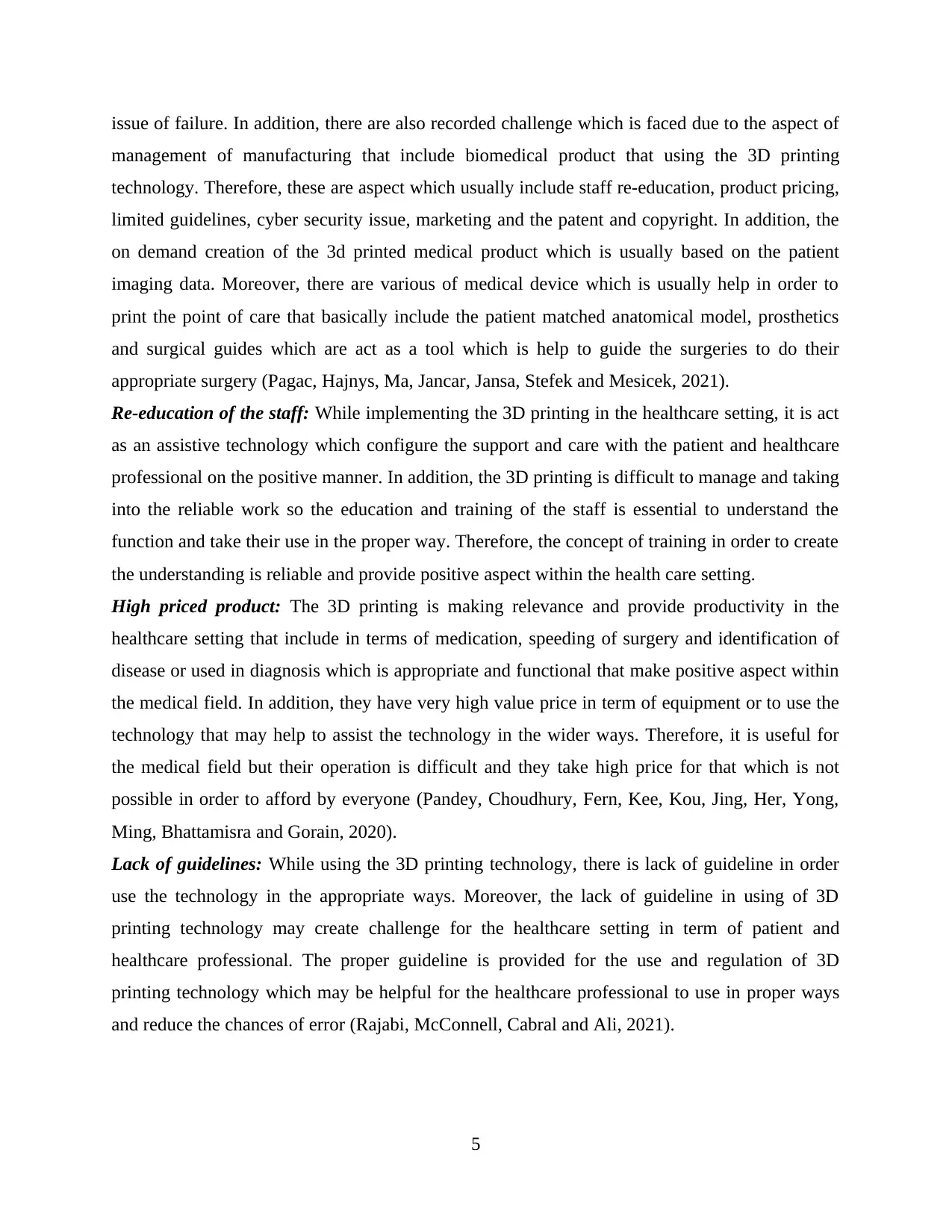
issue of failure. In addition, there are also recorded challenge which is faced due to the aspect of
management of manufacturing that include biomedical product that using the 3D printing
technology. Therefore, these are aspect which usually include staff re-education, product pricing,
limited guidelines, cyber security issue, marketing and the patent and copyright. In addition, the
on demand creation of the 3d printed medical product which is usually based on the patient
imaging data. Moreover, there are various of medical device which is usually help in order to
print the point of care that basically include the patient matched anatomical model, prosthetics
and surgical guides which are act as a tool which is help to guide the surgeries to do their
appropriate surgery (Pagac, Hajnys, Ma, Jancar, Jansa, Stefek and Mesicek, 2021).
Re-education of the staff: While implementing the 3D printing in the healthcare setting, it is act
as an assistive technology which configure the support and care with the patient and healthcare
professional on the positive manner. In addition, the 3D printing is difficult to manage and taking
into the reliable work so the education and training of the staff is essential to understand the
function and take their use in the proper way. Therefore, the concept of training in order to create
the understanding is reliable and provide positive aspect within the health care setting.
High priced product: The 3D printing is making relevance and provide productivity in the
healthcare setting that include in terms of medication, speeding of surgery and identification of
disease or used in diagnosis which is appropriate and functional that make positive aspect within
the medical field. In addition, they have very high value price in term of equipment or to use the
technology that may help to assist the technology in the wider ways. Therefore, it is useful for
the medical field but their operation is difficult and they take high price for that which is not
possible in order to afford by everyone (Pandey, Choudhury, Fern, Kee, Kou, Jing, Her, Yong,
Ming, Bhattamisra and Gorain, 2020).
Lack of guidelines: While using the 3D printing technology, there is lack of guideline in order
use the technology in the appropriate ways. Moreover, the lack of guideline in using of 3D
printing technology may create challenge for the healthcare setting in term of patient and
healthcare professional. The proper guideline is provided for the use and regulation of 3D
printing technology which may be helpful for the healthcare professional to use in proper ways
and reduce the chances of error (Rajabi, McConnell, Cabral and Ali, 2021).
5
management of manufacturing that include biomedical product that using the 3D printing
technology. Therefore, these are aspect which usually include staff re-education, product pricing,
limited guidelines, cyber security issue, marketing and the patent and copyright. In addition, the
on demand creation of the 3d printed medical product which is usually based on the patient
imaging data. Moreover, there are various of medical device which is usually help in order to
print the point of care that basically include the patient matched anatomical model, prosthetics
and surgical guides which are act as a tool which is help to guide the surgeries to do their
appropriate surgery (Pagac, Hajnys, Ma, Jancar, Jansa, Stefek and Mesicek, 2021).
Re-education of the staff: While implementing the 3D printing in the healthcare setting, it is act
as an assistive technology which configure the support and care with the patient and healthcare
professional on the positive manner. In addition, the 3D printing is difficult to manage and taking
into the reliable work so the education and training of the staff is essential to understand the
function and take their use in the proper way. Therefore, the concept of training in order to create
the understanding is reliable and provide positive aspect within the health care setting.
High priced product: The 3D printing is making relevance and provide productivity in the
healthcare setting that include in terms of medication, speeding of surgery and identification of
disease or used in diagnosis which is appropriate and functional that make positive aspect within
the medical field. In addition, they have very high value price in term of equipment or to use the
technology that may help to assist the technology in the wider ways. Therefore, it is useful for
the medical field but their operation is difficult and they take high price for that which is not
possible in order to afford by everyone (Pandey, Choudhury, Fern, Kee, Kou, Jing, Her, Yong,
Ming, Bhattamisra and Gorain, 2020).
Lack of guidelines: While using the 3D printing technology, there is lack of guideline in order
use the technology in the appropriate ways. Moreover, the lack of guideline in using of 3D
printing technology may create challenge for the healthcare setting in term of patient and
healthcare professional. The proper guideline is provided for the use and regulation of 3D
printing technology which may be helpful for the healthcare professional to use in proper ways
and reduce the chances of error (Rajabi, McConnell, Cabral and Ali, 2021).
5
Paraphrase This Document
Need a fresh take? Get an instant paraphrase of this document with our AI Paraphraser
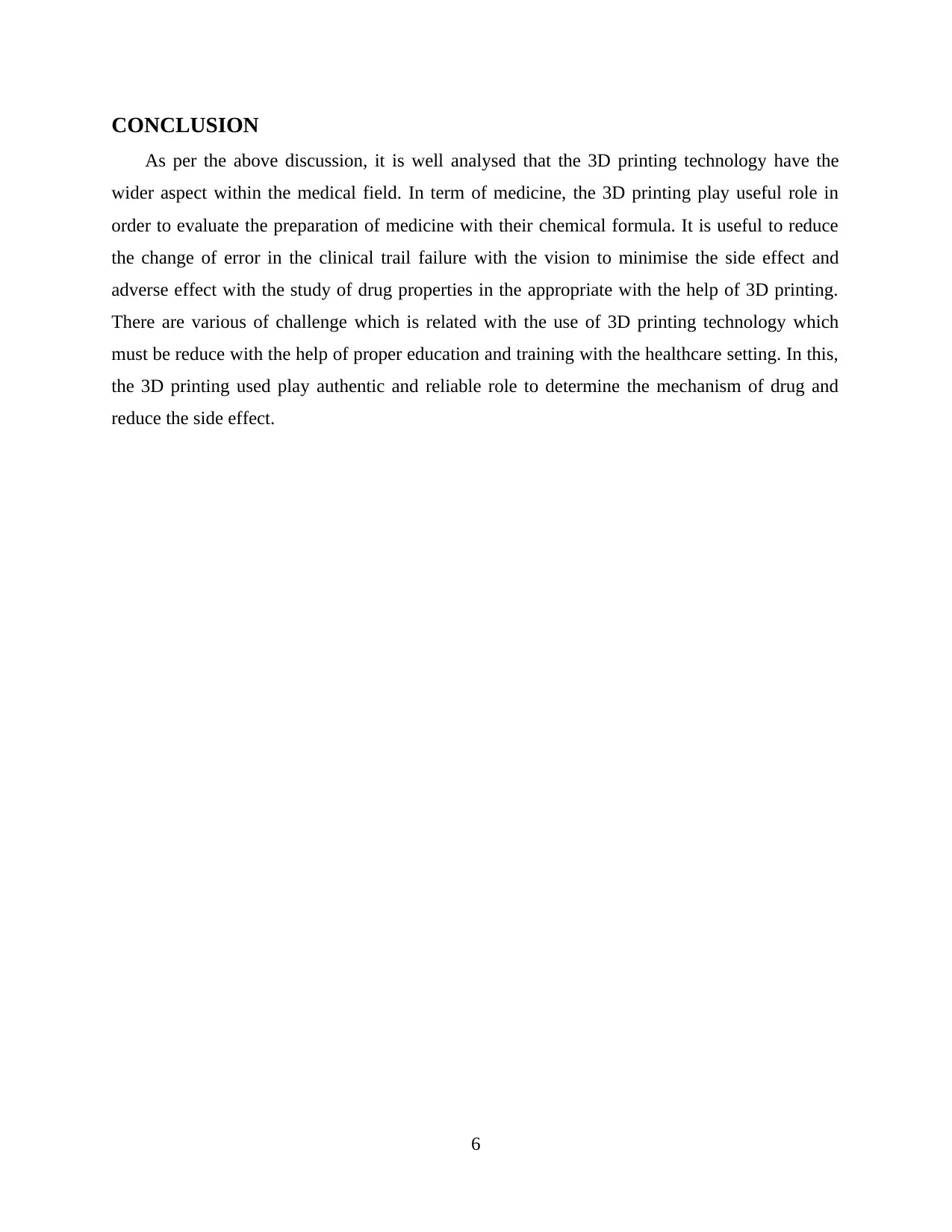
CONCLUSION
As per the above discussion, it is well analysed that the 3D printing technology have the
wider aspect within the medical field. In term of medicine, the 3D printing play useful role in
order to evaluate the preparation of medicine with their chemical formula. It is useful to reduce
the change of error in the clinical trail failure with the vision to minimise the side effect and
adverse effect with the study of drug properties in the appropriate with the help of 3D printing.
There are various of challenge which is related with the use of 3D printing technology which
must be reduce with the help of proper education and training with the healthcare setting. In this,
the 3D printing used play authentic and reliable role to determine the mechanism of drug and
reduce the side effect.
6
As per the above discussion, it is well analysed that the 3D printing technology have the
wider aspect within the medical field. In term of medicine, the 3D printing play useful role in
order to evaluate the preparation of medicine with their chemical formula. It is useful to reduce
the change of error in the clinical trail failure with the vision to minimise the side effect and
adverse effect with the study of drug properties in the appropriate with the help of 3D printing.
There are various of challenge which is related with the use of 3D printing technology which
must be reduce with the help of proper education and training with the healthcare setting. In this,
the 3D printing used play authentic and reliable role to determine the mechanism of drug and
reduce the side effect.
6
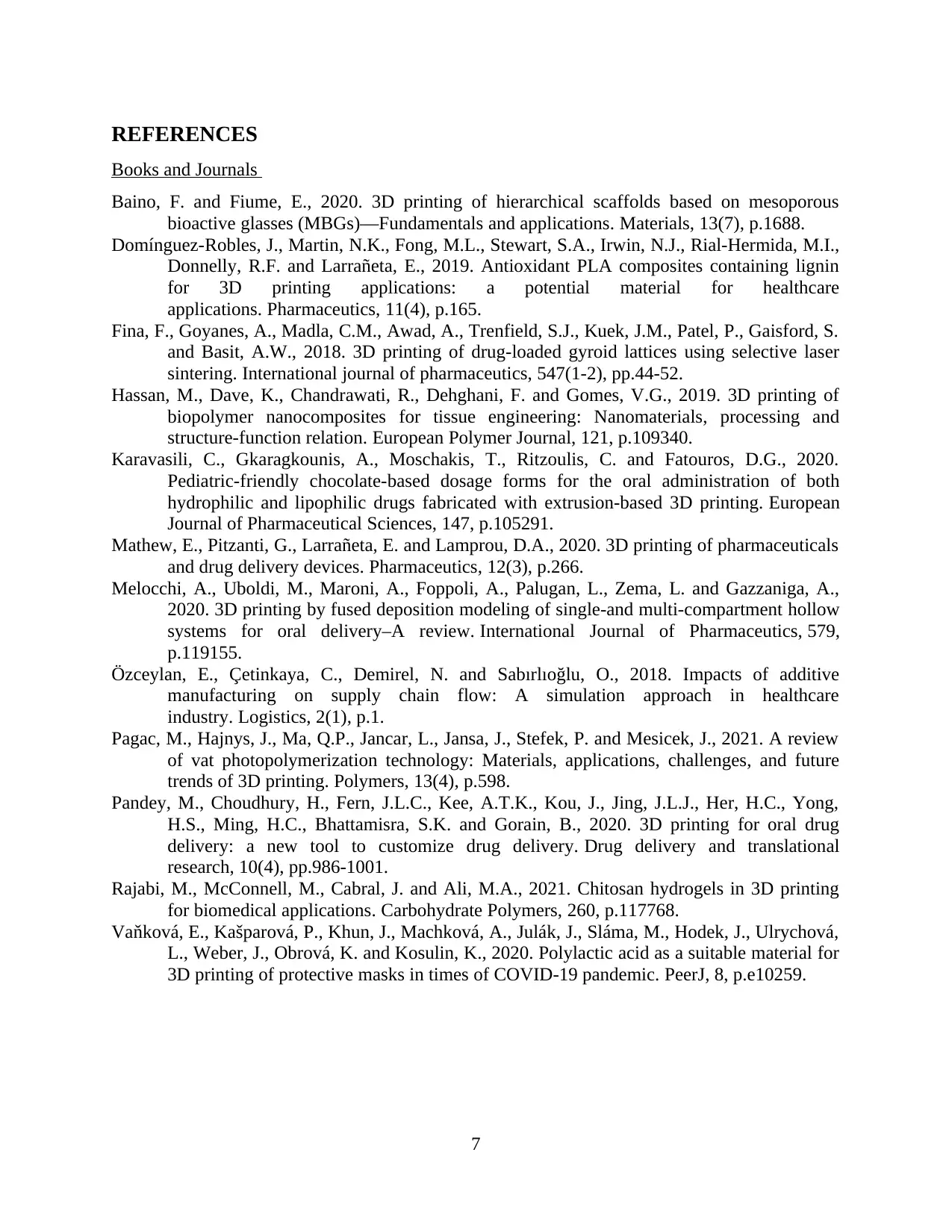
REFERENCES
Books and Journals
Baino, F. and Fiume, E., 2020. 3D printing of hierarchical scaffolds based on mesoporous
bioactive glasses (MBGs)—Fundamentals and applications. Materials, 13(7), p.1688.
Domínguez-Robles, J., Martin, N.K., Fong, M.L., Stewart, S.A., Irwin, N.J., Rial-Hermida, M.I.,
Donnelly, R.F. and Larrañeta, E., 2019. Antioxidant PLA composites containing lignin
for 3D printing applications: a potential material for healthcare
applications. Pharmaceutics, 11(4), p.165.
Fina, F., Goyanes, A., Madla, C.M., Awad, A., Trenfield, S.J., Kuek, J.M., Patel, P., Gaisford, S.
and Basit, A.W., 2018. 3D printing of drug-loaded gyroid lattices using selective laser
sintering. International journal of pharmaceutics, 547(1-2), pp.44-52.
Hassan, M., Dave, K., Chandrawati, R., Dehghani, F. and Gomes, V.G., 2019. 3D printing of
biopolymer nanocomposites for tissue engineering: Nanomaterials, processing and
structure-function relation. European Polymer Journal, 121, p.109340.
Karavasili, C., Gkaragkounis, A., Moschakis, T., Ritzoulis, C. and Fatouros, D.G., 2020.
Pediatric-friendly chocolate-based dosage forms for the oral administration of both
hydrophilic and lipophilic drugs fabricated with extrusion-based 3D printing. European
Journal of Pharmaceutical Sciences, 147, p.105291.
Mathew, E., Pitzanti, G., Larrañeta, E. and Lamprou, D.A., 2020. 3D printing of pharmaceuticals
and drug delivery devices. Pharmaceutics, 12(3), p.266.
Melocchi, A., Uboldi, M., Maroni, A., Foppoli, A., Palugan, L., Zema, L. and Gazzaniga, A.,
2020. 3D printing by fused deposition modeling of single-and multi-compartment hollow
systems for oral delivery–A review. International Journal of Pharmaceutics, 579,
p.119155.
Özceylan, E., Çetinkaya, C., Demirel, N. and Sabırlıoğlu, O., 2018. Impacts of additive
manufacturing on supply chain flow: A simulation approach in healthcare
industry. Logistics, 2(1), p.1.
Pagac, M., Hajnys, J., Ma, Q.P., Jancar, L., Jansa, J., Stefek, P. and Mesicek, J., 2021. A review
of vat photopolymerization technology: Materials, applications, challenges, and future
trends of 3D printing. Polymers, 13(4), p.598.
Pandey, M., Choudhury, H., Fern, J.L.C., Kee, A.T.K., Kou, J., Jing, J.L.J., Her, H.C., Yong,
H.S., Ming, H.C., Bhattamisra, S.K. and Gorain, B., 2020. 3D printing for oral drug
delivery: a new tool to customize drug delivery. Drug delivery and translational
research, 10(4), pp.986-1001.
Rajabi, M., McConnell, M., Cabral, J. and Ali, M.A., 2021. Chitosan hydrogels in 3D printing
for biomedical applications. Carbohydrate Polymers, 260, p.117768.
Vaňková, E., Kašparová, P., Khun, J., Machková, A., Julák, J., Sláma, M., Hodek, J., Ulrychová,
L., Weber, J., Obrová, K. and Kosulin, K., 2020. Polylactic acid as a suitable material for
3D printing of protective masks in times of COVID-19 pandemic. PeerJ, 8, p.e10259.
7
Books and Journals
Baino, F. and Fiume, E., 2020. 3D printing of hierarchical scaffolds based on mesoporous
bioactive glasses (MBGs)—Fundamentals and applications. Materials, 13(7), p.1688.
Domínguez-Robles, J., Martin, N.K., Fong, M.L., Stewart, S.A., Irwin, N.J., Rial-Hermida, M.I.,
Donnelly, R.F. and Larrañeta, E., 2019. Antioxidant PLA composites containing lignin
for 3D printing applications: a potential material for healthcare
applications. Pharmaceutics, 11(4), p.165.
Fina, F., Goyanes, A., Madla, C.M., Awad, A., Trenfield, S.J., Kuek, J.M., Patel, P., Gaisford, S.
and Basit, A.W., 2018. 3D printing of drug-loaded gyroid lattices using selective laser
sintering. International journal of pharmaceutics, 547(1-2), pp.44-52.
Hassan, M., Dave, K., Chandrawati, R., Dehghani, F. and Gomes, V.G., 2019. 3D printing of
biopolymer nanocomposites for tissue engineering: Nanomaterials, processing and
structure-function relation. European Polymer Journal, 121, p.109340.
Karavasili, C., Gkaragkounis, A., Moschakis, T., Ritzoulis, C. and Fatouros, D.G., 2020.
Pediatric-friendly chocolate-based dosage forms for the oral administration of both
hydrophilic and lipophilic drugs fabricated with extrusion-based 3D printing. European
Journal of Pharmaceutical Sciences, 147, p.105291.
Mathew, E., Pitzanti, G., Larrañeta, E. and Lamprou, D.A., 2020. 3D printing of pharmaceuticals
and drug delivery devices. Pharmaceutics, 12(3), p.266.
Melocchi, A., Uboldi, M., Maroni, A., Foppoli, A., Palugan, L., Zema, L. and Gazzaniga, A.,
2020. 3D printing by fused deposition modeling of single-and multi-compartment hollow
systems for oral delivery–A review. International Journal of Pharmaceutics, 579,
p.119155.
Özceylan, E., Çetinkaya, C., Demirel, N. and Sabırlıoğlu, O., 2018. Impacts of additive
manufacturing on supply chain flow: A simulation approach in healthcare
industry. Logistics, 2(1), p.1.
Pagac, M., Hajnys, J., Ma, Q.P., Jancar, L., Jansa, J., Stefek, P. and Mesicek, J., 2021. A review
of vat photopolymerization technology: Materials, applications, challenges, and future
trends of 3D printing. Polymers, 13(4), p.598.
Pandey, M., Choudhury, H., Fern, J.L.C., Kee, A.T.K., Kou, J., Jing, J.L.J., Her, H.C., Yong,
H.S., Ming, H.C., Bhattamisra, S.K. and Gorain, B., 2020. 3D printing for oral drug
delivery: a new tool to customize drug delivery. Drug delivery and translational
research, 10(4), pp.986-1001.
Rajabi, M., McConnell, M., Cabral, J. and Ali, M.A., 2021. Chitosan hydrogels in 3D printing
for biomedical applications. Carbohydrate Polymers, 260, p.117768.
Vaňková, E., Kašparová, P., Khun, J., Machková, A., Julák, J., Sláma, M., Hodek, J., Ulrychová,
L., Weber, J., Obrová, K. and Kosulin, K., 2020. Polylactic acid as a suitable material for
3D printing of protective masks in times of COVID-19 pandemic. PeerJ, 8, p.e10259.
7
⊘ This is a preview!⊘
Do you want full access?
Subscribe today to unlock all pages.

Trusted by 1+ million students worldwide

8
1 out of 10
Related Documents
Your All-in-One AI-Powered Toolkit for Academic Success.
+13062052269
info@desklib.com
Available 24*7 on WhatsApp / Email
![[object Object]](/_next/static/media/star-bottom.7253800d.svg)
Unlock your academic potential
Copyright © 2020–2025 A2Z Services. All Rights Reserved. Developed and managed by ZUCOL.




